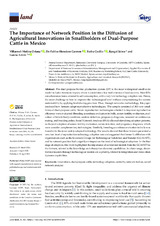Mostrar el registro sencillo del ítem
The Importance of Network Position in the Diffusion of Agricultural Innovations in Smallholders of Dual-Purpose Cattle in Mexico
| dc.contributor.author | Villarroel-Molina, Oriana | |
| dc.contributor.author | Pablos-Heredero, Carmen de | |
| dc.contributor.author | Barba Capote, C.J. | |
| dc.contributor.author | Rangel Quintos, Jaime | |
| dc.contributor.author | García, Antón | |
| dc.date.accessioned | 2021-04-12T11:25:18Z | |
| dc.date.available | 2021-04-12T11:25:18Z | |
| dc.date.issued | 2021 | |
| dc.identifier.uri | http://hdl.handle.net/10396/21250 | |
| dc.description.abstract | The dual-purpose bovine production system (DP) is the most widespread small-scale model in Latin American tropics, where it constitutes a key tool in terms of food security. Most DPs are subsistence farms oriented to self-consumption, with a very low technology adoption rate. Hence, the main challenge is how to improve the technological level without compromising the system sustainability by applying land-sharing practices. Thus, through networks methodology, this paper analysed how farmers adopt reproductive technologies. The sample consisted of 383 very small farms of dual-purpose cattle. Seven reproduction technologies oriented to improve reproductive efficiency were evaluated: Breeding soundness evaluation in bulls, semen fertility evaluation, evaluation of female body condition, oestrus detection, pregnancy diagnosis, seasonal or continuous mating, and breeding policy. Social Network Analysis (SNA) allowed identifying adoption patterns, as the joint adoption of semen fertility evaluation, estrus detection, and pregnancy diagnosis, which were consider complementary technologies. Similarly, breeding soundness evaluation in bulls was found to be the most widely adopted technology. The results showed that these farmers presented a very low level of reproduction technology adoption rate and suggested that farmer’s affiliation with organizations such as the Livestock Groups for Technological Validation and Transfer (GGAVATT), and its network position had a significant impact on the level of technological adoption. In the first stage of adoption, this work highlighted the importance of centralized models from the GGAVATT to the farmers, related to the knowledge and absorption dynamic capabilities. In a later stage, decentralized models through technological leaders are a priority, related to integration and innovation dynamic capabilities. | es_ES |
| dc.format.mimetype | application/pdf | es_ES |
| dc.language.iso | eng | es_ES |
| dc.publisher | MDPI | es_ES |
| dc.rights | https://creativecommons.org/licenses/by/4.0/ | es_ES |
| dc.source | Land 10(4), 401 (2021) | es_ES |
| dc.subject | Innovations | es_ES |
| dc.subject | Dual-purpose cattle | es_ES |
| dc.subject | Technology adoption | es_ES |
| dc.subject | Centrality network indices | es_ES |
| dc.subject | Social network analysis | es_ES |
| dc.title | The Importance of Network Position in the Diffusion of Agricultural Innovations in Smallholders of Dual-Purpose Cattle in Mexico | es_ES |
| dc.type | info:eu-repo/semantics/article | es_ES |
| dc.relation.publisherversion | http://dx.doi.org/10.3390/land10040401 | es_ES |
| dc.rights.accessRights | info:eu-repo/semantics/openAccess | es_ES |

